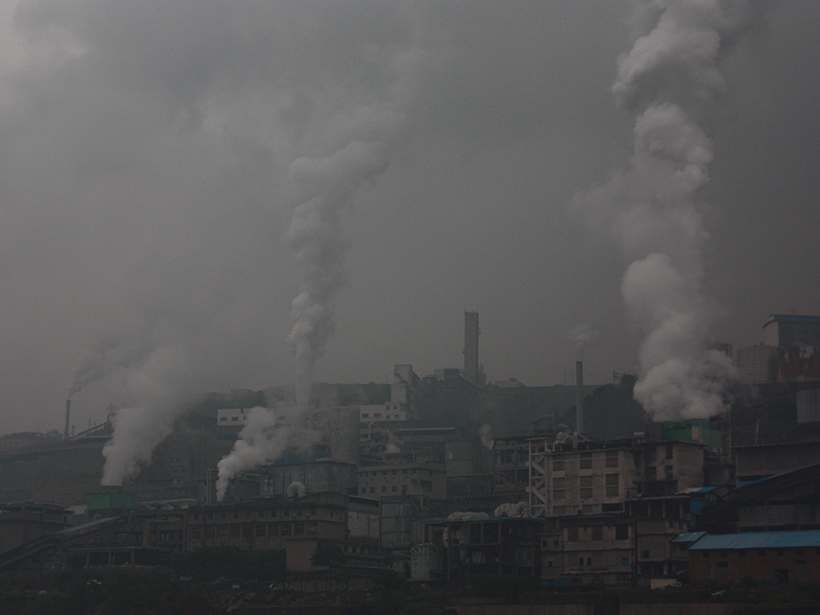The field of atmospheric chemistry should improve its predictive capability to better anticipate and help people prepare for potential environmental and human health challenges, a new report urges. This and other steps recommended by a committee of the U.S. National Academy of Sciences (NAS) could help to reduce air quality risks related to increasing energy demands, intensifying industrial and agricultural activities, a growing and more urbanized population, and other factors, according to the report, which is entitled The Future of Atmospheric Chemistry Research and was released on 25 August.
“The future challenges for atmospheric chemistry involve nothing less than the health of the planet’s climate, the health of ecosystems, and the health of humans everywhere,” the report states. Atmospheric chemistry research has a history of helping with earlier challenges, including contributing to guiding policies that have cut urban smog, acid rain, and chemicals implicated in depleting stratospheric ozone, the committee states.
The report calls for a broad research program in atmospheric chemistry and identifies five priority areas of research to help guide the field over the next decade—a period during which the committee anticipates flat federal funding. Although the field of atmospheric chemistry has expanded over the past several decades, “the amount of funding for research in the field has not increased substantially,” the report notes.
At a 25 August briefing about the report, committee cochair Barbara Finlayson-Pitts said that even assuming a flat budget, creative proposals from the atmospheric chemistry community could continue to move the field forward.
The overall goal is that by about 2030 “we could predict accurately what will happen if we change anything that impacts the atmosphere.”
Finlayson-Pitts, a professor of chemistry at the University of California, Irvine, said that an overall goal is that by about 2030 “we could predict accurately what will happen if we change anything that impacts the atmosphere.” She said that would include natural and anthropogenic emissions and their spatial and temporal distributions, temperature, and relative humidity.
She elaborated that if atmospheric chemists “could predict what is going to happen and what would change if we change [those] inputs in various ways, that would be the goal.”
Finlayson-Pitts told Eos that a bigger budget would not change the committee’s recommendations, “but it would get us to that predictive capability much faster.”
“Given how fast the atmosphere is changing, with climate change and a changing population and so on, it is going to be hard to stay ahead of the curve. So the faster we can do this, the better off we are going to be in terms of avoiding the worst impacts of a lot of these issues in times to come,” she said.
Science Goals for the Next Decade
The report focuses on two priority science areas for advancing fundamental atmospheric chemistry. For one, the report calls for developing a more robust predictive capability to understand the distributions, reactions, and lifetimes of gases and particles. For the other, it recommends quantifying emissions and the deposition of gases and particles in a changing Earth system.
Another three areas highlighted by the report would help the field meet societal challenges by improving climate modeling and weather forecasting, clarifying the role of atmospheric chemistry in human health impacts, and understanding atmospheric chemistry feedbacks on natural and managed ecosystems.
The report points to some urgent current challenges related to atmospheric chemistry, including air pollution, which causes one out of eight deaths globally, according to the World Health Organization. Climate change and better understanding the evolving mix of energy sources also pose pressing challenges to human health and the environment, according to the report.
Dual Role of Atmospheric Research
“Atmospheric chemistry research alone cannot solve these major problems, but…they cannot be solved without it.”
Atmospheric chemistry research encompasses basic and applied research, which the report refers to as a dual role. The report notes that “on the one hand [atmospheric chemistry’s role is] to observe, learn, and discover for the sake of fundamentally understanding the Earth system and the underlying chemical, physical and biological processes.” But the field must also fulfill another role, the report adds, “to advance research to address those challenges that directly affect society. Atmospheric chemistry research alone cannot solve these major problems, but it is also true that they cannot be solved without it.”
The report, sponsored by the U.S. National Science Foundation (NSF), also recommends a series of infrastructure goals. These call for NSF to ensure the development of tools to accomplish science goals, take the lead in coordinating with other agencies to codevelop long-term research sites, and better utilize past and current data sets.
Agency Response
Sylvia Edgerton, program director for NSF’s atmospheric chemistry program, told Eos that the committee did a good job in making recommendations while recognizing a flat budget. She said that one reason she wanted NSF to support the report was to get more visibility for the field. “People don’t recognize the importance” of atmospheric chemistry, she said.
At the briefing, Finlayson-Pitts said that atmospheric chemistry “has a very impressive track record in solving problems that really affect human health and welfare, and we believe that it has a very bright and impactful future ahead.” The committee will hold a webinar about the report on 23 September.
—Randy Showstack, Staff Writer
Citation:
Showstack, R. (2016), Atmospheric chemists should tackle risks to society, report says, Eos, 97, https://doi.org/10.1029/2016EO059075. Published on 09 September 2016.
Text © 2016. The authors. CC BY-NC-ND 3.0
Except where otherwise noted, images are subject to copyright. Any reuse without express permission from the copyright owner is prohibited.

